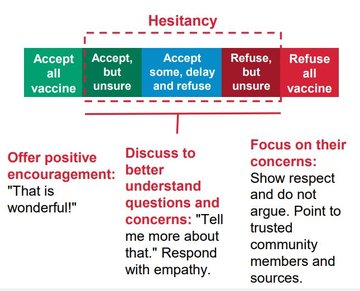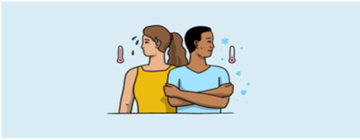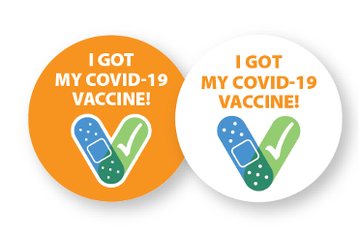Handling Vaccine Hesitancy and Misinformation
Vaccine hesitancy is when people are worried 😧 about vaccines or refuse vaccines even if they're available. People may hesitate to get vaccines for different reasons. Many things can shape a person's ideas about vaccines and it depends on the context and the type of vaccines. Often a lack of trust in the vaccines importance, safety or effectiveness can lead to hesitancy.
Some people may be hesitant because they don't know what's in the vaccine, or they don't believe they are at risk. For others it may be because they had a negative experience with a previous vaccination, or for religious reasons. It's important to understand why a person is hesitant and to build trust with the individuals and your community so you can address their specific concerns.
Studies show that some messages to convince people to get a vaccine can make them even more hesitant. Messages that create fear and panic can make people feel that they are being forced to get vaccinated and are not very effective. Take the time to have discussions with people so they feel in control about the decision to vaccinate.
Remind people why its important to vaccinate and what the benefits are. Work with people who are trusted by your community to share positive stories about vaccinations in your community. Think of your audience's thoughts, attitudes, beliefs, and values. Always check ✔ that your messages are safe to use for your audience.

- Thoughts, feelings
- Attitudes, cognitive diases
- Trust, social norms, beliefs, experiences, fears
- Moral values, ideology, identity, worldview
Managing Vaccine Hesitancy
As a health worker, together with your supervisor, you must control false information and find the real concerns people have. Follow these 4 steps to handle messages: Prepare, Listen, Understand, and Engage.
- PREPARE 📋 by building a team and a plan.
- LISTEN 👂🏽 by having a system that can track messages.
- UNDERSTAND 🔍 where they come from and which ones to address. Then,
- ENGAGE 💬 the community. Warn them of messages that are spreading. Explain how you know a myth is false and any hidden purposes you found related to the messages.

As a community health worker, you play a key role in COVID-19 vaccination success. Use empathy to put yourself in the community member's position. This helps you better understand their challenges and fears. Caring behaviors can build trust and increase acceptance of COVID-19 vaccines.♥

Because peoples feelings about vaccines vary, remember to tailor your communication to the person's position on the vaccine. Here are some messages to share with different audiences.
- For people who accept only some vaccines: remind people of how vaccines used in the community have prevented many diseases and that COVID-19 vaccines work in the same way. Also share that COVID-19 vaccines have been proven to be safe.
- For people who accept vaccines but are unsure: share that COVID-19 vaccines have been tested and proven to protect people and communities against COVID-19.
- For people who refuse all vaccines: This group of people may never change their minds. It's best to spend time and effort on those who are willing to get vaccinated, but need to be heard and reassured about COVID-19 effectiveness and safety.
Misinformation and Disinformation About the Vaccine
Ideas about vaccines can spread quickly, even if they haven't been proven true or false. When a message is shared by accident (they don't know it's false), it is misinformation. When a message that is false is shared on purpose, it is disinformation. Anti-vaccine messages might have a hidden purpose, such as to increase fear or make money. But many worried people believe these messages because they have real concerns.
Managing Misinformation and Disinformation
It is common for rumors and misinformation to spread during a pandemic. People may have heard misinformation from the media, their friends or family. So, it is important that you always give people the facts, and if you don't know the facts, let the person know you will find the information and come back to them. Be sure to prioritize your messages and provide the most up-to-date information.
Handling Misinformation About Vaccine Side Effects
Many people get minor side effects from the COVID-19 vaccine, especially after the second dose. This is normal but you may hear misinformation about the side effects in your community. Thus, as a community healthworker, you can share the correct facts about the side effects, such as sharing what the common side effects are: fever 🤒, headache, and muscle pain.
The vaccine side effects don't last long and normally go away after 1-3 days. Experincing side effects indicates that your body is working to protect you against COVID-19. If you get side effects with the first shot it's still very important to get the second shot. Watch this video to learn more about the side effects.
If you cannot view the above video, you can instead download it.

Some might get a severe allergic reaction to vaccines, like hives, swelling, and difficulty breathing. It's very rare and happens minutes after vaccination if it happens at all. Everyone who gets the vaccine is monitored for at least 15 minutes to see if they have such an allergic reaction ⏲
Handling Misinformation About Vaccine Safety
Concerns about the safety of the vaccine have led to the spread of misinformation. Share with the community that safety is a top priority of all vaccines. Some people may decide that they would rather develop protection from COVID-19 by getting the virus rather than through the vaccine. Explain that the chances of severe illness and complications if a person gets sick from COVID-19 are much higher. Getting the vaccine can help eliminate this risk and provide protection.
But, how do we know the vaccine is safe? Safety data from the vaccine trials was reviewed carefully by governments around the world as well as international organizations that specialize in vaccine safety. No major safety concerns were found for COVID-19 vaccines that have been approved. The safety continues to be monitored by governments and other organizations.
Assure the community members that the COVID-19 vaccines are being held to the same safety standards as all vaccines developed. The vaccines were tested in a diverse mix of people in multiple countries and no serious safety concerns were found for any population. People with allergies should talk to their provider. Unless they are allergic to an ingredient in the vaccine, they should still get the vaccine. For pregnant and breastfeeding women, data is limited, but experts believe they are safe for these women. Pregnant and breastfeeding women may want to discuss it with their provider first.
Handling Misinformation About Taking the Vaccine With the Rise of Variants
Variants are a result of a virus changing over time (mutating) 🦠 A virus grows by making copies, but some copies have changes (mutations). Even with COVID-19 variants, the vaccines we have now can still protect us 👍🏽
Building Vaccine Confidence
Vaccine confidence is when people trust the vaccines, trust the people who give the vaccine, and trust the process behind making the vaccine 😎 Studies show that vaccine acceptance depends on knowing the side effects, effectiveness, safety, and the cost and ease of getting the vaccine. Building vaccine confidence is essential to help with vaccine hesitancy and misinformation.
Increase vaccine confidence by building trust through community engagement. Share clear, complete, and factual messages about vaccines. Know what their questions, doubts and fear are, and respond to them specifically.

USE CHAMPIONS 🏆 As a healthcare worker, you can act as a vaccine champion by sharing your experience of getting vaccinated! Give them ways to make their vaccination visible through stickers, buttons, or sharing in media.
ENGAGE 💬 Host discussions with community that allow them to have their vaccine questions answered.
Information Monitoring
Information monitoring is a key part of community engagement. Keeping track of information being shared in the community helps you find COVID-19 vaccine rumors quickly and respond to them before they reach too many people 🛑 Find out what COVID-19 vaccine questions people in your community are asking. You can try to find it from phone hotline reports, vaccine site reports, or social media 💬


